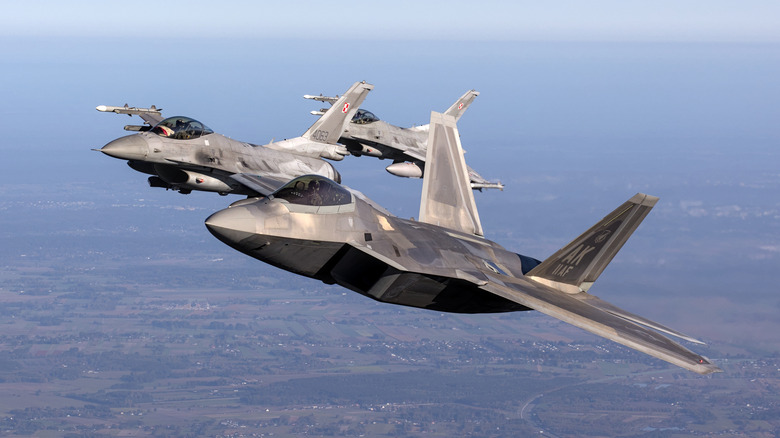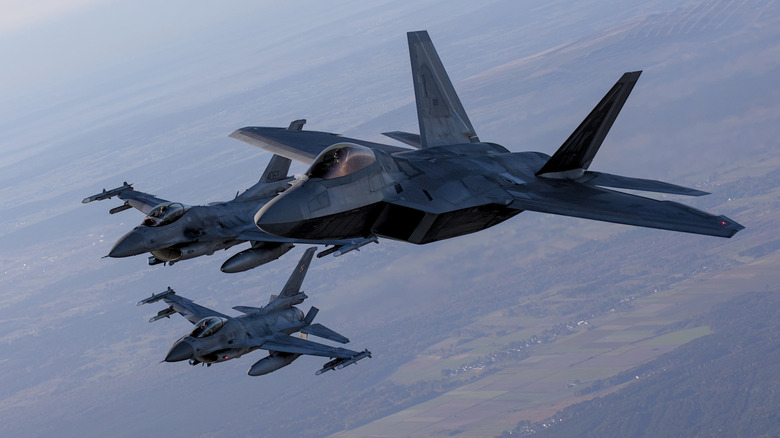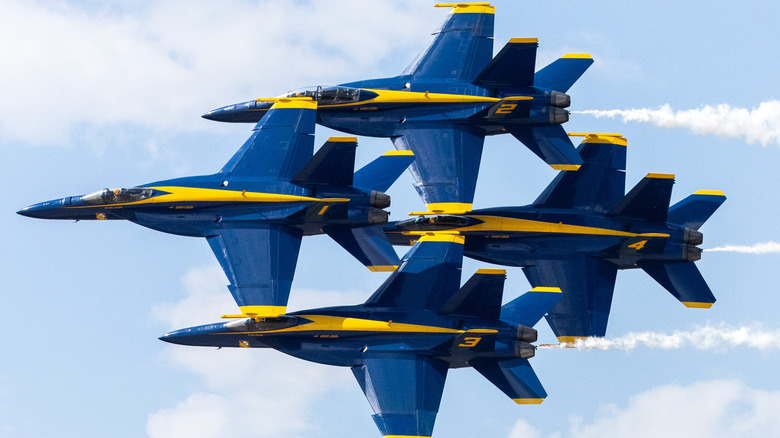Why Do Fighter Jets Fly So Close To Each Other?
If you've ever seen new pilots in the jets the U.S. Air Force uses for training or fighter jets in action, you've probably noticed how tightly they fly together. Sometimes it looks like they're just inches apart and could crash into each other at any moment. So even though it's a breathtaking display of precision and skill, it's also a testament to the pilots' mental fortitude.
The reason for the close formation has to do with combat, as flying together allows pilots to more easily protect each other during an attack and perform complex aerial tactics. The jets can also maneuver as a single and more stable unit, improving fuel economy. Then there's the visibility, as being so close together gives the pilots the ability to communicate with hand signals if needed, which was especially important during World War I, before advanced radar and communication technology.
Flying in such close proximity to each other only works because of the cooperation between pilots. The most experienced pilot leads the way — known as the flight leader — flanked by wingmen, who ensure their positions are consistent throughout the flight. Whether they're training or in active combat, wingmen must follow the lead of the pilot in front at all times.
Fighter jet pilots need advanced skills to fly in tight formations
The Federal Aviation Administration (FAA) regulates formation flying, with standard formation dictating fighter jets be no farther than 1 mile apart. The FAA also says they can be within 100 feet from the flight leader and while this is the norm, nonstandard formations are acceptable under certain situations, like when the lead pilot requests it. But what does it take to fly in such tight formations?
Jet fighter pilots must have advanced skills, which means being able to expertly control the jet and keep a consistent flight path, despite the weather. They should also communicate clearly to the other pilots to ensure everyone's safety while in the air. Being able to pivot during challenging conditions is important too, as quick decision making is paramount. Of course, having the knowledge of how to correctly fly in close formations is another important key to safety.
When it comes to the formations fighter pilots can choose from, there are options, including the V-formation, in which jets fly in two V columns like birds. Then there's the Echelon, where the jets create a diagonal column. When the jets line up one behind the other is simply known as a line formation. The Squadron formation features pilots flying in columns of four to six jets. A Diamond formation best describes the pattern jets will take together during parade flights. Each formation serves a different purpose and all of them can be essential.
Close formation flying is often on display at military airshows
Fighter jets flying close together isn't just reserved for combat situations. It's also on display at airshows, where such spectacular aerial acrobatics play out before a cheering audience. These pilots are among the best in the world and when it comes to putting on an amazing show, two organizations stand out from the rest.
The Blue Angels, the U.S. Navy's flying team, is comprised of 140 Navy sailors and Marines that use tight formations to perform seemingly impossible maneuvers and have been doing so since 1946. Their formations are similar to those used in combat but they often come dangerously close to each other, sometimes getting as near as 18 inches apart. While the Blue Angels aren't used in combat, their jets are suited for it and can be modified to be ready for battle in as little as three days.
The U.S. Air Force Thunderbirds date back to 1953 and features eight top pilots, along with over 130 personnel that bring their thrilling shows to life. Like the Blue Angels, the Thunderbirds' formations are tight, with jets coming within 18 inches of each other.


